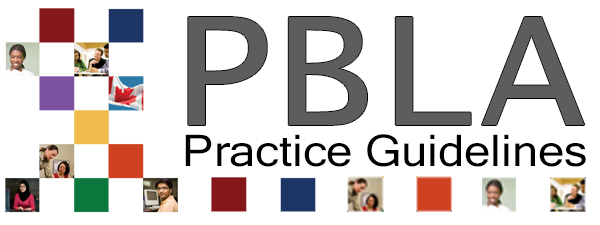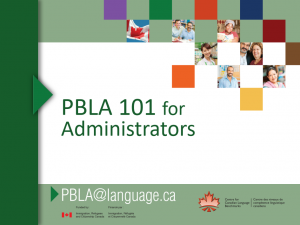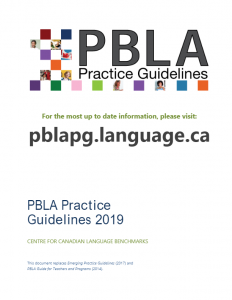PBLA Background
Supplement 2: Bibliography
Supplement 2: Bibliography
Akbari, R. (2008). Transforming lives: Introducing critical pedagogy into ELT classrooms. ELT Journal, 62(3), 276-283.
Ali, S. Y. (2005). An introduction to electronic portfolios in the language classroom. The Internet TESL Journal, 11(8). Retrieved from http://iteslj.org/Techniques/Ali-Portfolios.html
Anderson, N. (1999). Exploring Second Language Reading: Issues and Strategies. Boston, MA: Heinle & Heinle.
Andrews, S. (2007). Teacher Language Awareness. Cambridge, UK: Cambridge University Press.
Assessment Reform Group. (1999). Assessment for learning: Beyond the black box
Bailey, K. M. (1998). Learning about Language Assessment: Dilemmas, Decisions, and Directions. Boston, MA: Heinle & Heinle.
Bell, J. (2004). Teaching Multilevel Classes in ESL. Toronto, ON: Pippin.
Bell, J., & Burnaby, B. (1994). A Handbook for ESL Literacy. Toronto, ON: OISE Press.
Black, P. J., & Wiliam, D. (1998). Inside the Black Box: Raising Standards through Classroom Assessment. London, UK: King’s College London School of Education.
Boston, Carol. (2002). The concept of formative assessment. Practical Assessment, Research, and Evaluation, 8(9). Retrieved from http://PAREonline.net/getvn.asp?v=8&n=9
Brindley, G. (1989). The role of needs analysis in adult ESL programme design. In R. K. Johnson (Ed.), The Second Language Curriculum (pp. 63-78). Cambridge, UK: Cambridge University Press.
Brown, G., & Yule, G. (1983). Teaching the Spoken Language: An Approach Based on the Analysis of Conversational English. Cambridge, UK: Cambridge University Press.
Bullock, K., Bishop, K., Martin, S., & Reid, A. (2002). Learning from coursework in English and Geography. Cambridge Journal of Education, 32, 325-340.
Burns, A., & Joyce, H. (1997). Focus on Speaking. Sydney, Australia: NCELTR.
Butler, K. (1987). Learning and Teaching Style: In Theory and Practice. Columbia, CT: The Learners’ Dimension.
Celce-Murcia, M., & Olshtain, E. (2000). Discourse and Context in Language Teaching: A Guide for Language Teachers. Cambridge, UK: Cambridge University Press.
Centre for Canadian Language Benchmarks. (2014). Canadian Language Benchmarks for ESL Literacy. Ottawa, ON: www.language.ca.
Centre for Canadian Language Benchmarks. (2000). Canadian Language Benchmarks 2000: ESL for Literacy Learners. Ottawa, ON: www.language.ca.
Centre for Canadian Language Benchmarks. (2007). Canadian Language Benchmarks 5-10: Exit Assessment Tasks. Ottawa, ON: www.language.ca.
Centre for Canadian Language Benchmarks. (2012a). Canadian Language Benchmarks: ESL for Adults. Ottawa, ON: www.language.ca.
Centre for Canadian Language Benchmarks. (2012b). CLB Support Kit. Ottawa, ON: www.language.ca.
Chang, C. (2001). A study on the evaluation and effectiveness analysis of web-based learning portfolio (WBLP). British Journal of Educational Technology, 32(4), 435-458.
Cisco, Intel, Microsoft. (2009). Transforming Education: Assessing and Teaching 21st Century Skills. Retrieved from http://tinyurl.com/6ukgq6
Collins, J. (2004). Education techniques for lifelong learning: Principles of adult learning. RadioGraphics, 24, 1483-1489.
Cotterall, S. (2000). Promoting learner autonomy through the curriculum: Principles for designing language courses. ELT Journal, 54, 109-117.
Crookes, G., & Lehner, A. (1998). Aspects of process in an ESL critical pedagogy teacher education course. TESOL Quarterly, 32(2), 319-328.
Daugherty, R. (2011). Designing and implementing a teacher-based assessment system: Where is the infrastructure? Paper presented at the seminar Teachers’ Judgments within Systems of Summative Assessment: Strategies for Enhancing Consistency, St. Anne’s College, Oxford, UK, 20-22 June. Retrieved from http://oucea.education.ox.ac.uk/wordpress/wp-content/uploads/2011/07/Daugherty-FINAL.pdf
Davies, A. (2000). Making Classroom Assessment Work. Merville, BC: Classroom Connections International.
Davison C., & Leung C. (2009). Current issues in English language teacher-based assessment. TESOL Quarterly, 43(3), 393-415.
Delett, J. S., Barnhardt, S., & Kevorkian, J. A. (2001). A framework for portfolio assessment in the foreign language classroom. Foreign Language Annals, 34(6), 559-568.
DeSilva Joyce, H., & Burns, A. (1999). Focus on Grammar. Sydney, Australia: NCELTR.
Dörnyei, Z. (2001a). Motivational Strategies in the Classroom. Cambridge, UK: Cambridge University Press.
Dörnyei, Z. (2001b). Teaching and Researching Motivation. Harlow, UK: Pearson Education.
Dörnyei, Z. (2003). Attitudes, orientations, and motivations in language learning: Advances in theory, research and applications. In Z. Dörnyei (Ed.), Attitudes, Orientations, and Motivations in Language Learning (pp. 3-32). Oxford, UK: Blackwell.
Feez, S. (1998). Text-Based Syllabus Design. Sydney, Australia: AMES.
Finnegan, D. M. (2006). E-learning success: Readability versus reading skill. International Journal of Instructional Technology and Distance Learning, 3(10). Retrieved from http://www.itdl.org/Journal/Oct_06/article04.htm
Flowerdew, L. (2000). Using a genre-based framework to teach organizational structure in academic writing. ELT Journal, 54, 369-378.
Fullan, M. (2004). System Thinkers in Action: Moving beyond the Standards Plateau. Nottingham, UK: Department for Education and Skills Innovation Unit. Retrieved from http://www.michaelfullan.ca/media/13396063090.pdf
Fullan, M. (2006). Change theory: A force for school improvement. Seminar Series Paper No. 157. Melbourne, Australia: Centre for Strategic Education.
Fullan, M., & Pomfret, A. (1977). Research on curriculum and instruction implementation. Review of Educational Research, 47(2), 335-397. Retrieved from http://rer.aera.net.
Gardner, J. (Ed.). (2012). Assessment and Learning (2nd ed.). London, UK: Sage.
Gladwell, M. (2000). The Tipping Point. Boston, MA: Little, Brown.
Grabe, W., & Stoller, F. L. (2002). Teaching and Researching Reading. Harlow, UK: Pearson Education.
Harlen, W. (2004). A systematic review of the evidence of reliability and validity of assessment by teachers used for summative purposes. In Research Evidence in Education Library. London: EPPI-Centre, Social Science Research Unit, Institute of Education.
Hattie, J. (2009). Visible Learning: A Synthesis of Over 800 Meta-Analyses Relating to Achievement. New York: Routledge.
Henry, A., & Roseberry, R. L. (1998). An evaluation of a genre-based approach to the teaching of EAP/ESP writing. TESOL Quarterly, 32(1), 147-156.
Holmes, T. (2005). Integrating CLB Assessment into Your ESL Classroom. Ottawa, ON: Centre for Canadian Language Benchmarks.
Holmes, T., Kingwell, G., Pettis, J., & Pidlaski, M. (2001). Canadian Language Benchmarks 2000: Guide to Implementation. Ottawa, ON: Centre for Canadian Language Benchmarks.
Hood, S., Solomon, N., & Burns, A. (2002). Focus on Reading (New ed.). Sydney, Australia: NCELTR.
Hsiao, T-Y., & Oxford, R. L. (2002). Comparing theories of language learning strategies: A confirmatory factor analysis. Modern Language Journal, 86(3), 368-383.
Hyland, K. (2002a). Genre: Language, context, and literacy. Annual Review of Applied Linguistics, 22,113-115.
Hyland, K. (2002b). Teaching and Researching Writing. Harlow, UK: Pearson Education.
Johns, A. M. (Ed.). (2002). Genre in the Classroom: Multiple Perspectives. Mahwah, NJ: Lawrence Erlbaum.
Johnson, S. (2011). A Focus on Teacher Assessment Reliability in GCSE and GCE. Coventry, UK: Office of Qualifications and Examinations Regulation.
Kern, R. (2000). Literacy and Language Teaching. Oxford, UK: Oxford University Press.
Kohonen, V. (2000). Student reflection in portfolio assessment: Making language learning more visible. Babylonia, 1, 13-16.
Kramsch, C., & Nolden, T. (1994). Redefining literacy in a foreign language. Die Unterrichtspraxis, 27(1), 28-35.
Latham, G. P., & Pinder, C. C. (2005). Work motivation theory and research at the dawn of the 21st century. Annual Review of Psychology, 56, 485–516.
Leahy, S., Lyon, C., Thompson, M., & Wiliam, D. (2005). Classroom assessment that keeps learning on track minute-by-minute, day-by-day. Educational Leadership, 63(3), 19-24.
Leahy, S., & Wiliam, D. (2011). From teachers to schools: Scaling up professional development for formative assessment. In J. Gardner (Ed.), Assessment and Learning (2nd ed.) (pp. 49-72). London, UK: Sage.
Litz, D. (2007). Student-directed assessment in ESL/EFL: Designing scoring rubrics with students. The Internet TESL Journal 13(11). Retrieved from http://iteslj.org/Lessons/Litz-StudentDirectedAssessment.html
Liu, P., Lara, R., & Parker, R. (2001). Using standardized tests unconventionally: An adapted reading assessment. Reading Improvement, 38(1), 27-37.
Locke, E. A., & Latham, G. P. (2002). Building a practically useful theory of goal setting and task motivation: A 35-year odyssey. American Psychologist, 57, 705-717.
McDonald, B., & Boud, D. (2003). The impact of self-assessment on achievement: The effects of self-assessment training on performance in external examinations. Assessment in Education: Principles, Policy and Practice, 10(2), 209.
Makosky, L. (2008). The Feasibility and Way Forward for a Standardized Exit Assessment and Test for Newcomers in LINC Training. Internal report prepared for Citizenship and Immigration Canada, Ottawa.
Martin, A. J. (2006). Personal bests (PBs): A proposed multidimensional model and empirical analysis. British Journal of Educational Psychology, 76, 803-825.
Merriam, S. B. (2001). Andragogy and self-directed learning: Pillars of adult learning theory. New Directions for Adult and Continuing Education, 89, 3-13.
Miholic, V., & Moss, M. (2001). Rethinking portfolio applications and assessment. Journal of College Reading and Learning, 32(1), 5-13.
Nagy, P. & Stewart, G. (2009). Research study on potential approaches to second language assessment. Internal report prepared for Citizenship and Immigration Canada, Ottawa.
Newcombe, L. P., & Newcombe, R. G. (2001). Adult language learning: The effect of background, motivation and practice on perseverance. International Journal of Bilingual Education and Bilingualism, 4(5), 332-354.
Ohara, Y., Saft, S., & Crookes, G. (2000). Teacher exploration of feminist/critical pedagogy in a beginning Japanese as a foreign language class. Paper presented to the Department of ESL, University of Hawai’I at Manoa, 22 March. Retrieved from http://www2.hawaii.edu/~crookes/crpj.html
Ontario Ministry of Education. (2013). Descriptive Feedback: Assessment for Learning Video Series. Viewing Guide. Toronto, ON: Ministry of Education. Retrieved from http://www.edugains.ca/resourcesAER/VideoLibrary/Feedback/ViewingGuideFeedbackAfLVideoSeries.pdf
Oxford, R. L. (1990). Language Learning Strategies: What Every Teacher Should Know. Boston, MA: Heinle & Heinle.
Oxford, R. L., Cho, Y., Leung, S., & Kim, H. (2004). Effect of the presence and difficulty of task on strategy use: An exploratory study. International Review of Applied Linguistics, 42, 1-47.
Paltridge, B. (2001). Genre and the Language Learning Classroom. Ann Arbor: University of Michigan Press.
Paltridge, B. (2002). Genre, text type, and the English for academic purposes (EAP) classroom. In A. M. Johns (Ed.), Genre in the Classroom: Multiple Perspectives (pp. 73-90). Mahwah, NJ: Lawrence Erlbaum.
Pawlinowska-Smith, G. (2005). Summative Assessment Manual (SAM). Ottawa, ON: Centre for Canadian Language Benchmarks.
Pettis, J. (2009). Collaborative Language Portfolio Assessment (CLPA): Manitoba Best Practices Guide. Winnipeg, Manitoba:Adult Language Training Branch.
Richards, J. C., Platt, J., and Platt, H. (1992). Dictionary of Language Teaching and Applied Linguistics (2nd ed.). Harlow, UK: Longman.
Rost, M. (2002). Teaching and Researching Listening. Harlow, UK: Pearson Education.
Swales, J. M. (1990). Genre Analysis: English in Academic and Research Settings. Cambridge, UK: Cambridge University Press.
Thornbury, S. (2005). How to Teach Speaking. Harlow, UK: Longman.
Thornbury, S., & Slade, D. (2006). Conversation: From Description to Pedagogy. Cambridge, UK: Cambridge University Press.
Tiangco, J.A.N.Z. (2005). Project-based learning (PBL) assessment for EFL/ESL instruction: The Philippine experience and its implications to Taiwan.
Watt, D.L.E., & Lake, D.M. (2004). Benchmarking Adult Rates of Second Language Acquisition & Integration: How long and how fast? Edmonton, AB: Alberta Learning, Language Training Programs and Citizenship and Immigration Canada.
Wiliam, D. (2011). Embedded Formative Assessment. Bloomington, IN: Solution Tree Press.
Yorke, M. (2003). Formative assessment in higher education: Moves towards theory and the enhancement of pedagogic practice. Higher Education 45 (4): 477-501.
Yule, G. (1998). Explaining English Grtammar. Oxford, UK: Oxford University Press.
Part A1
1Federal, Provincial, Territorial Forum. 2009. “Pan-Canadian Environmental Scan.” Prepared by Alberta Employment and Immigration Policy and Programs Branch, Calgary.
Part A3
Walsh, A. (2006). Working with IMGs: Delivering effective feedback. A Faculty Development Program for Teachers of International Medical Graduates. Ottawa, ON: Association of Faculties of Medicine of Canada. Retrieved from http://www.mentornetwork.net/LinkClick.aspx?fileticket=G96KPBKoHHE%3D&tabid=93
For Part B1, p 3 – Internet references to
EL Educational Leadership; September 2012 | Volume 70 | Number 1 ; Feedback for Learning Pages 10-16: Seven Keys to Effective Feedback; Grant Wiggins
For Part B2
Citizenship and Immigration Canada. Education Division. March 2010. Evaluation of the Language Instruction for Newcomers to Canada (LINC) Program. R&E ref No.: ER201102_01E . www.cic.gc.ca/English/resources/evaluation/linc/2010/linc-eval.pdf
Part B5
National Placement and Progression Guidelines. 2013 Bibliographic info can be found at http://www.language.ca/en/index.cfm?Voir=sections&Id=18256&M=4032&Repertoire_No=2137991327
Part C1
Everett Rogers (Diffusion of Innovations, 5th Edition. 2003. New York: Free Press)
John Fisher (2012) http://www.businessballs.com/personalchangeprocess.htm)
Part C2
(Adapted from Concordia University, Portland, OR, Blog, “Four Instructional Leadership Skills Principals Need,” http://education.cu-portland.edu) direct link is http://education.cu-portland.edu/blog/ed-leadership/four-instructional-leadership-skills-principals-need/


